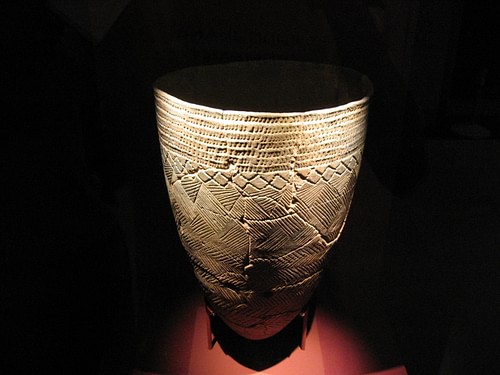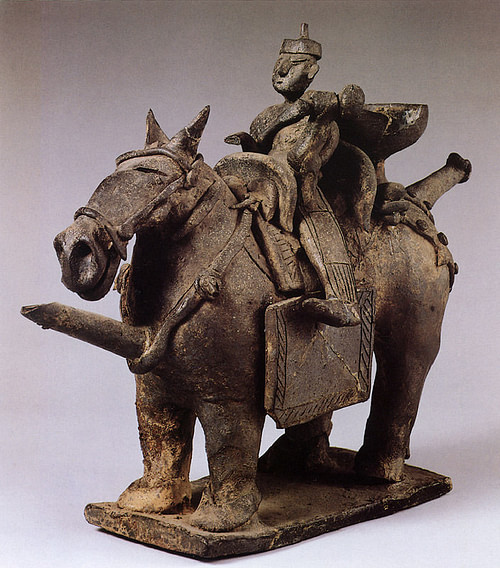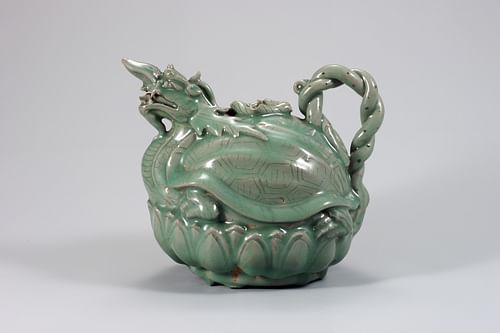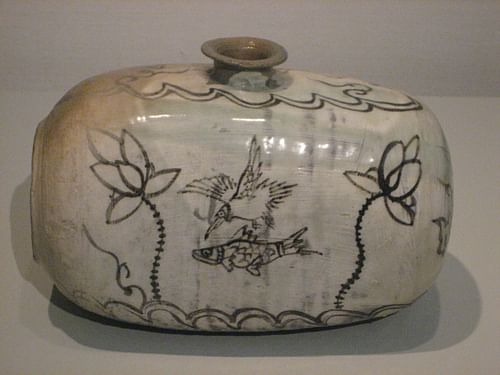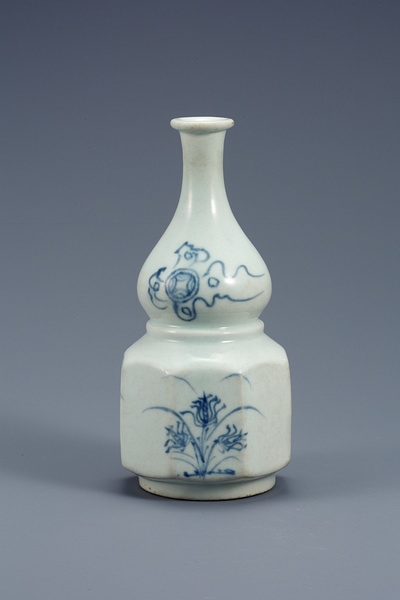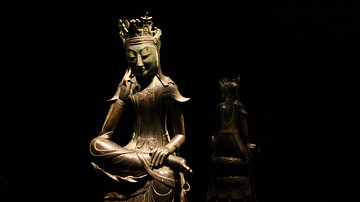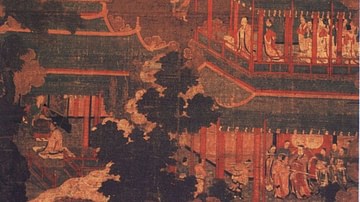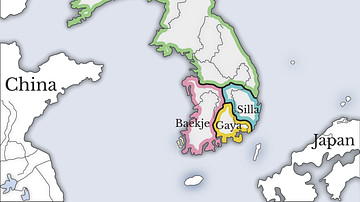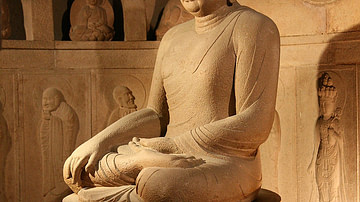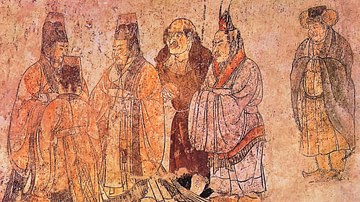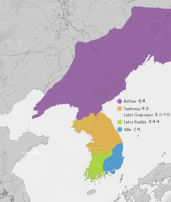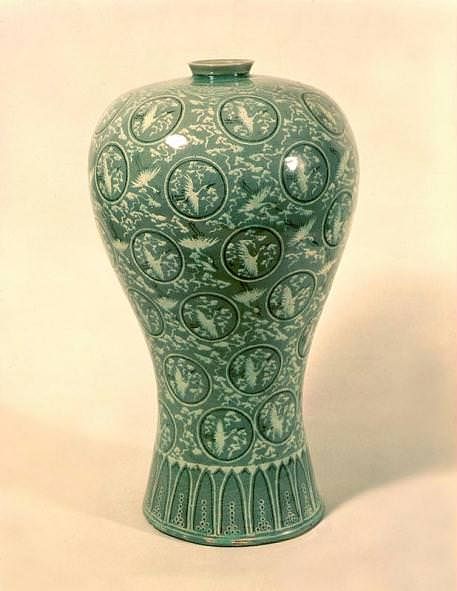
The pottery of ancient Korea stretches back to prehistory when simple brown wares were made and decorated with geometrical incisions. Potters would benefit from the ideas and techniques of their Chinese counterparts and go on to produce their own highly sought-after works, including grey stoneware, celadons or greenware, buncheong ware and white porcelain. Ceramics are innovative in design and range from impossibly intricate incense burners to the sublime simplicity and elegance of the maebyeong vase. Korean Pottery decoration typically employs plants, flowers, and wildlife, and reflects the country's religious heritage with Buddhist motifs and minimalist Confucian designs taking precedence.
Prehistoric Pottery
Early Korean pottery from the Neolithic period, especially in the form of brown bowls with either a flat or pointed base, both with incised decoration, show a cultural link with communities in the Liaoning province and Liaodong peninsula of China. The most common decoration of this period is zigzag or comb-like incisions which have given the name to a type of pottery: comb wares (chulmun). Some vessels have square spiral incisions while others have raised decorations achieved by pinching the clay.
Korean Bronze Age pottery tends to be undecorated, walls are thicker, and there is a greater variety of shapes - typically steamers, bowls with pedestals, and jars with handles. When there is decoration, it covers less of the vessel and takes either the form of the incised motifs of the previous period or applied clay bands. Burnished wares are either black (long-necked jars) or red (small bulbous jars). These are, once again, indicative of contact with China.
Iron Age pottery is of a grey type with paddle and incised decoration, especially close hatching. A typical form of this period is the round-bottomed jar which has a small foot and distinctive small handles on the neck in the form of horns. Another interesting shape is the square cup set on a pedestal which is then lacquered black. It is clear that potters are becoming more skilled and more ambitious in their designs, setting the groundwork for the finer vessels to come in the Three Kingdoms period.
Grey Stoneware
High-fired grey stoneware was produced by the Baekje, Gaya, and Silla kingdoms (little Goguryeo pottery survives) from the 1st century BCE to the 10th century CE. Typical forms are the stemmed cup, bowls with wide stands (kobae), long-necked jars (changgyong ho), round, lidded cups with a wide foot base known as kobae, horned cups, stands (kurut pachim) used to support large bowls, tall bulbous vases (sometimes with pierced stands), lamps, and bell cups which have small pieces of clay inside a hollow lower section so that they rattle when lifted, and spouted figure-vessels representing animals, boats, temples, horse-riding warriors, and even houses. Ceramics were decorated with incisions, applying additional clay pieces, and cutting away the clay to create a latticework effect.
Stoneware requires a high firing temperature, and this technology was, no doubt, connected to the furnaces required to produce iron in the Gaya confederation which was rich in that metal. Gaya potters likely passed on this innovation to Japan, where the famous sueki (or sue) stoneware would be produced as a result. Baekje potters also produced low-fired pottery, light brown in colour. Bulbous jars, footed vessels, tripods, and roof tiles are common shapes.
As the Three Kingdoms period gave way to the Unified Silla period (668-935 CE), Korean pottery began to display a marked influence from Buddhism. Cremation necessitated the manufacture of urns for ashes and Buddhist motifs prevail as stamped decoration such as lotus buds, lotus flowers, and clouds. Everyday pottery was left undecorated, but special pieces show a greater density of decoration than previously and there are even some human figures such as musicians playing the kayagum (zither). There is, too, the first ash glaze which would develop into the later celadon ceramics of the Goryeo period.
Celadon
The celadon (or greenware) ceramics produced during the Goryeo Dynasty (918-1392 CE), are regarded as some of the finest and most elegant pottery pieces produced anywhere. They are typified by their pale green lustre reminiscent of jade and a super smooth glaze. First produced in China, celadon quickly gained popularity across Asia and in Korea specifically from the 9th century CE when there was increased contact with the Song Dynasty. It may be that the colour association with precious jade was another reason for celadon's success. The green colour is achieved by firing the clay in an oxygen-reducing kiln with a glaze containing a low percentage of iron oxide (cheolhwa). The method gives an extremely smooth surface to the finished vessel, although many fine cracks in the glaze are typical, even desirable.
Initially, the Korean wares were rather crude, but by the 12th century CE Korean celadon ceramics were even finer than those produced in China. The popularity and esteem with which celadons were held are attested by their presence in royal Korean tombs. With the Mongol invasions of the peninsula and the systematic destruction of workshops in the 13th century CE production of celadons was, unfortunately, brought to a halt.
Vases, jugs, and bowls were the most popular shapes for celadons and the quintessential form was the tall vase with a narrow base and bulbous neck known as a maebyeong. Potters also produced a myriad of other items such as ceramic pillows, pitchers in the form of monks or mythical dragonfish creatures, incense burners topped by animal figures through whose mouths the incense smoke exits, cosmetic boxes, water droppers (kundika, used to sprinkle water in Buddhist ceremonies), and even curvaceous roof tiles were all executed with the finesse seen in more classical vessels.
Vessels were decorated with low or high relief designs, especially floral patterns using the lotus leaf and flower, peony and chrysanthemum flowers, grapevines, and birds such as waterfowl. Many motifs, especially cranes and clouds, are associated with Buddhism. Vessels left undecorated often have simple linear designs engraved on them while others have more intricate black, red, brown, and white clay inlays in a technique unique to Korea known as sanggam. Here designs are carved on the surface and the inlays added before applying a translucent slip. Some later vessels were also inlaid with gold. The inlays are so fine and the workmanship of such a high standard that, on the finished vessel, they appear to be brush strokes. Adding a dark red colour to pick out designs or used for outlines became common in the later period of Korean celadons, achieved by using a copper underglaze - the first such instance in world ceramics. Another popular decorative effect was to add mouldings which could then also be made into openwork.
Buncheong Wares
Buncheong (punchong) wares, blue-green ceramic covered with a white slip, are the most practical of Korea's offerings to world ceramics. They were produced in the 15th and 16 century CE during the Joseon dynasty (1392-1910 CE) and initially are very similar to celadons. Unlike other types of Korean pottery, buncheong was produced by non-state controlled potteries and so became much more eclectic and influenced by regional preferences and the wishes of the ordinary people who ordered their manufacture. Typical shapes include maebyeong vases, bulbous vases with tall necks, cylinder flasks with a single top spout, and flat turtle-shaped bottles with a small side spout. All of these served a practical use in the home.
Buncheong designs became much busier than those on celadon wares with more of the surface used. Designs were etched onto the white slip (johwa) or carved into the clay with a sharp tool and then filled with white slip before firing. Sometimes stamps (inhwa) were used to apply simple geometrical decoration (especially in the south-east) or were applied with a brush (kwiyal) using a brown iron oxide underglaze, particularly popular in central provinces. Finally, white or red clay could be inlaid into the carved design (the sanggam technique used with celadon). Besides geometric forms, designs typically employ peony flowers (symbol of wealth), birds, and dots. Pairs of fish are particularly common as these represented good fortune, fertility, and happiness.
Maksabal & Onggi
An off-shoot or by-product of buncheong was the humble maksabal bowl which used clay not deemed good enough for buncheong production. Maksabal means 'bowl to be used right away' which indicates their low quality, but they were, nevertheless, a means for potters to freely express their artistry. Another common vessel type purely of a functional nature are the onggi storage vases and cooking vessels. Those for storage had lids, and because of the impurities in the poor quality clay, minute holes formed in the vessels when fired. These tiny holes allow air to circulate, and so onggi were used to store foodstuffs such as soy sauce and fish paste. Onggi were also frequently buried in the ground and even used as lavatories. They are often decorated with bold curved lines created by the potter using his thumbs when the glaze was still wet.
White Porcelain
White porcelain (paekcha) was also made during the Joseon dynasty and came to replace buncheong in popularity, especially following the destruction of many potteries during the Japanese invasions in the late 16th century CE. White porcelain had actually been in production since the 9th century CE, but it was in this period that its manufacture was finally perfected so that it was both thinner and more durable than any previous Korean ceramics, whiter than ever before, and had a very smooth glaze. One major production centre was Bunwon at Gwangju where 300 kilns have been excavated, but such was the popularity of white porcelain that potteries sprang up across the country to meet demand. Such was its importance that, eventually, white porcelain could only be produced in official state-sponsored kilns and its quality is evidenced in its appearance on tribute lists to Ming China.
Bowls, bevelled bottles, pear-shaped vases, squat bulbous jars with lids, 'Moon' jars (so-called because of their circular form), brush holders, epitaph tablets, and water droppers in animal or fruit shapes were common. Sometimes forms are deliberately made asymmetrical which is especially noticeable in moon jars and something which makes Korean ceramics distinct from Chinese or Japanese wares.
The minimalist designs on Korean white porcelain reflect the austere simplicity of Confucianism which was followed by the ruling class of Joseon, although earlier examples are more filled as with Chinese blue and white porcelain of the time. Designs include flowers (especially lotus, orchid, and chrysanthemum), plants, bamboo (symbolic of integrity as it grows straight and true), grass, grape vines, willow trees, plum trees, birds, deer, dragons, and clouds, and are usually inlaid in the same way as celadons. Blue (initially from cobalt and then a cheaper substitute known as 'Mohammedan blue') or a brown (from iron oxide) underglaze are the usual colours used to render the designs.
Legacy
In the late 16th century CE many Korean potters and artists were forcibly taken to Japan following that country's invasion of the Korean peninsula in a conflict sometimes referred to as the 'Pottery Wars.' These artists, already admired for their white porcelain, would have a significant influence on Japanese Satsuma ware. Ancient Korean pottery still lives on today, too. Modern workshops using traditional methods are once again producing celadon ceramics, especially in the 16 kilns of Gangjin, where there is an annual celadon festival. Meanwhile, original celadons, in particular, still attract huge interest from collectors and can fetch the highest prices at auction houses of any ceramics produced anywhere.
This content was made possible with generous support from the British Korean Society.
